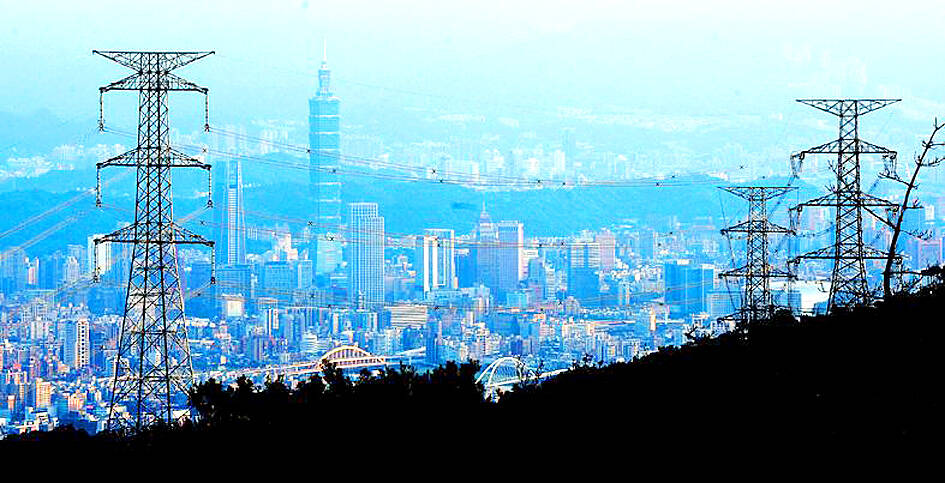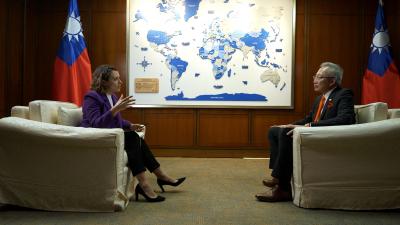The Chinese Nationalist Party (KMT) yesterday urged President William Lai (賴清德) to include energy security in the national security briefing.
Taiwan became a “nuclear-free” nation, after the No. 2 reactor of the Ma-anshan Nuclear Power Plant in Pingtung County’s Hengchun Township (恆春) was decommissioned on May 17.
However, state-run Taiwan Power Co (Taipower) has used two coal-fired generators at the Hsinta Power Plant and is thought to have activated the Talin Power Plant, both decommissioned and in Kaohsiung, prompting concerns over the nation’s power supply.

Photo: Lin Cheng-kun, Taipei Times
Lai in his inauguration anniversary speech last week said he would instruct his team to initiate a national security briefing for the heads of the opposition parties, expressing hope that it helps facilitate communications and cooperation between the ruling Democratic Progressive Party (DPP) and opposition parties.
To truly engage in meaningful communications with the opposition, Lai should include the energy issue in the national security briefing, the KMT said.
The president ignores the issue by focusing on stabilizing electricity prices and supply instead of considering going back to nuclear energy to enhance energy resilience, it said.
Nvidia founder and chief executive officer Jensen Huang (黃仁勳) has also suggested that Taiwan invest in nuclear energy, it said.
Huang on Wednesday last week at a forum on artificial intelligence (AI) said that energy from all sources, including nuclear power, is needed.
“Taiwan should absolutely invest in nuclear, and it shouldn’t be a stigma to have energy,” he said.
AI development requires the government to prioritize diverse energy sources, including nuclear power, the KMT quoted Huang as saying.
An American Chamber of Commerce in Taiwan survey showed that 82 percent of respondents said they were concerned about Taiwan’s energy supply, while local media reported that fossil fuel power generation accounted for up to 92 percent of it, and the nation’s energy security coefficient reached a dangerous high of 0.99, it said.
It also cited American Institute in Taiwan Director Raymond Greene as saying that Taiwan should consider nuclear energy and that Washington would be willing to provide technical support for nuclear development in Taiwan.
Lai is putting Taiwan in jeopardy by driving the nation into a nuclear-free era through the increased use of fossil fuels and the heavy reliance on imported energy at 97 percent, the KMT said.
If there is a regional conflict or disruption in the supply chain, Taiwan would lack the energy resilience it needs to defend itself, the party added.
While great powers such as the US are restarting nuclear reactors to cement their energy security and resilience, Lai chose to go against the trend, not only acting “irresponsibly” and risking domestic economic development, but also risking national security, it said.
The US has 96 active nuclear reactors, and 22 of them are expected to run for 80 years, while Japan has restarted 14 nuclear reactors, with the lifetime of eight of them extended to 60 years, it said.
The UK extended the lifetime of its four oldest nuclear power plants for at least 10 years to ensure energy supply, it said.
Finland has extended the lifetime of the Loviisa Nuclear Power Plant by 20 years until 2047, and Canada has revamped its Bruce Nuclear Generating Station, which is planned to run operations until 2064, it added.
Given that the annual growth rate of AI-related power demand is projected to be 25 percent to 30 percent, Lai is choking the future of Taiwan, the KMT said.
To follow the global trend and respond to people’s needs, the KMT has proposed amendments to the Nuclear Reactor Facilities Regulation Act (核子反應器設施管制法) to facilitate a return to nuclear energy, it said.
Separately, Taiwan People’s Party Chairman Huang Kuo-chang (黃國昌) yesterday said the alleged secret operation of decommissioned fossil fuel power plants rang an alarm bell about the DPP’s energy policy.
Many industrial leaders such as Pegatron Corp chairman Tung Tzu-hsien (童子賢) have urged the government to invest in energy, because stable power supply is crucial to industrial developments, and electricity use in households and small businesses, Huang added.
Additional reporting by Lo Kuo-chia

“China is preparing to invade Taiwan,” Deputy Minister of Foreign Affairs Francois Wu (吳志中) said in an exclusive interview with British media channel Sky News for a special report titled, “Is Taiwan ready for a Chinese invasion?” the Ministry of Foreign Affairs said today in a statement. The 25-minute-long special report by Helen Ann-Smith released yesterday saw Sky News travel to Penghu, Taoyuan and Taipei to discuss the possibility of a Chinese invasion and how Taiwan is preparing for an attack. The film observed emergency response drills, interviewed baseball fans at the Taipei Dome on their views of US President

The Central Weather Administration (CWA) today issued a "tsunami watch" alert after a magnitude 8.7 earthquake struck off the Kamchatka Peninsula in northeastern Russia earlier in the morning. The quake struck off the east coast of the Kamchatka Peninsula at 7:25am (Taiwan time) at a depth of about 19km, the CWA said, citing figures from the Pacific Tsunami Warning Center. The CWA's Seismological Center said preliminary assessments indicate that a tsunami could reach Taiwan's coastal areas by 1:18pm today. The CWA urged residents along the coast to stay alert and take necessary precautions as waves as high as 1m could hit the southeastern

ECONOMIC BENEFITS: The imports from Belize would replace those from Honduras, whose shrimp exports have dropped 67 percent since cutting ties in 2023 Maintaining ties with Taiwan has economic benefits, Ministry of Foreign Affairs officials said yesterday, citing the approval of frozen whiteleg shrimp imports from Belize by the Food and Drug Administration (FDA) as an example. The FDA on Wednesday approved the tariff-free imports from Belize after the whiteleg shrimp passed the Systematic Inspection of Imported Food, which would continue to boost mutual trade, the ministry said. Taiwan’s annual consumption of whiteleg shrimps stands at 30,000 tonnes, far exceeding domestic production, the ministry said. Taiwan used to fill the gap by importing shrimps from Honduras, but purchases slumped after Tegucigalpa severed diplomatic ties with Taiwan

The Executive Yuan yesterday approved a southwestern extension of the Sanying MRT Line from New Taipei to Bade District (八德) in Taoyuan, with a goal of starting construction by late 2026. The 4.03-kilometer extension, featuring three new stations, will run from the current terminus at Yingtao Fude Station (LB12) in New Taipei City to Dannan Station (LB14), where it will connect with Taoyuan’s Green Line, New Taipei City Metro Corp said in a statement. This extension will follow the completion of core Sanying Line, a 14.29-kilometer medium-capacity system linking Tucheng (土城), Sansia (三峽)